

Halfpenny
The dates 1691 and 1692 also occur. Some of those dated 1691 and 1692, have the date in the exergue as well as on
the edge. A further variety, of which an example is in the National Collection, has the heads on the obverse
considerably smaller, and the lettering also smaller. The edge of this piece is inscribed NVMMORUM.
FAMVLVS. 1690. A halfpenny in the same collection, and a specimen of which is also in the cabinet
of Mr. R. A. Hoblyn, has in the exergue the date 1691, but 1692 on the edge. Snelling mentions a halfpenny of
1689 with the date in the exergue, but this, if indeed it exists, which I doubt, should be a pattern struck late in
that year. In the sale of the coins of the late Mr. Edward Hawkins (1868, Lot 65) was a pattern halfpenny
with a tin centre, dated 1692.
Farthing
This has the date in the exergue of the reverse as well as on the edge. The following dates occur, 1690,
1691 and 1692.
Mr. Batty states that a tin farthing dated 1689 was once in his collection.
On the farthing of 1692 the date is sometimes with large figures, and sometimes with small ones. In the National
Collection is one of 1692 with a plain edge struck in copper, and another of the same year struck in a metal
apparently composed of a mixture of copper and brass. Specimens exist of farthings in pure copper struck in
1689, on which the head of the sovereigns somewhat resemble those on pattern No. 8, and these, it is presumed,
were mere patterns. There is a small star after BRITANNIA on these.
In 1694 a copper halfpenny and farthing were issued somewhat of the same type as that of the tin coinage, but
differing in having no legend on the edge, and the busts also differ considerably. In 1693 Andrew Corbet had
obtained a patent for the coinage of copper pieces but in 1694 this was withdrawn and a patent for seven years was
granted to Sir John Herne and others. Cast examples occur both of these pieces and of the similar pieces of
William III. alone.
Halfpenny
I have a bronzed proof of this in my collection, with larger and more finished lettering, and there is a similar
specimen in gold in the National Collection, and specimens in silver and copper are in the Collection of Mr.
Hoblyn.
Farthing
There are proofs of the farthings in silver. A farthing also occurs on a thick flan of copper of much
larger module than usual. Snelling mentions copper farthings of 1692 and 1693; an example of that of
1692 has recently occurred with long hair as on the tin coins, but I have not succeeded in tracing any
example of 1693.
The piece described as No. 1 in the first edition of this work is the variety of No. 3 without legends, referred
to under that number.
A variety of this pattern without legend on either side occurs in the National Collection and in my own.
This pattern is of extremely bold work, and in very high relief. The flan is small and thick. It was formerly
in the Tyssen, Durrant, Hawkins, Bergne (Lot 1012) and Addington collections, and is now in mine. It has been
described as a pattern farthing. An impression in silver was formerly in Mr. Copp's collection. Examples in
silver and copper are also said to be in the National Collection, and are described in Med. Ill., Vol. I., page 690
(No. 79).
The piece, described as No. 6 in the first edition of this work, has apparently the type of the ordinary
halfpenny of 1694 only, and cannot be said to constitute even a variety of it.
The occurs in copper and bronze and sometimes with an inner circle and sometimes without one, but both varieties
are very rare.
I have only met with two patterns which can with any degree of certainty be described as patterns for farthings.
9. In the National Collection and those of Mr. Hoblyn and myself, is a pattern farthing in copper, on which the
work is somewhat intermediate in character between Nos. 7 and 8, but more exactly resembling, and probably intended
as a companion piece to No. 7. The date on the reverse, in the exergue, is 1694, and the figure of Britannia,
which is seated on a globe, has the right leg bare as on the current farthings.
10. In Mr. Hoblyn's cabinet and in the National Collection are further patterns in copper for a farthing of the same
year, which in workmanship resemble more nearly and were probably also intended as patterns for companion pieces to
the finished proofs of the current halfpenny, having better lettering. As usual, the right leg of Britannia is
bare.
The following pieces have been described as patterns for a currency coinage, but although I now describe them in all
their varieties, quantum valeat, I cannot but think that they are merely medalets or jettons. Having regard to
the fact that William III. had come to the throne only by means of the flight of his predecessor and the consequent
extinction of the Stuart line, and knowing the strong feeling among the lower classes especially, in favour of what
was considered to be the divinely legitimate race, it is quite probable that he thought it politic to distribute
jettons of this kind, as widely as possible, to give publicity to and ensure recognition of his and his queen's
titles as reigning sovereign.
These pieces, the comparative degrees of rarity of which in their different metals, it is impossible to state with
any exactitude, are of two sizes--one smaller than the halfpenny and larger than the farthing, the other of a size
smaller than the farthing. Of the former the following four varieties occur:-
Med. Ill., Vol. I., p. 693, No. 88. This occurs in silver, copper, yellow metal, and white metal, and one in gold
in the National Collection, where (as also in my own collection) there is one of which half the coin is of copper
and the other half of brass.
Med. Ill., Vol. II., p. 64, No. 267. This occurs in silver and copper.
Med. Ill., Vol. II., p. 692, No. 87. This occurs in silver, copper, and tin; also partly in copper and partly in brass.
There were two reverse dies used for this piece (a) with IVNGIT commencing the legend at the
bottom of the coin, below the arms and (b) with SALVS ending the legend at the bottom of the
coin, below the arms.
This is in silver with a plain edge in the cabinet of Mr. R. A. Hoblyn and with a grained edge in my own.
Of the smaller pieces the following varieties occur:-
Med. Ill., Vol. I., p. 691, No. 81.
This is in silver, copper (thin and thick flans) and mixed metal, and a variety is in the National Collection of which
one third of the flan is of brass and the remainder of copper.
In my collection (from the late Mr. W. Brice's cabinet) is a specimen in copper of the size of the current farthing, which
may afford a slight argument in favour of the acceptance of these pieces as patterns for current coins.
Med. Ill., Vol. I., p. 691, No. 82.
Med. Ill., Vol. I., p. 695, No. 93.
This is in silver, copper and mixed metal. A variety in silver (Med. Ill., Vol. I., p. 695, No. 94) has the same
obverse but on the reverse is a rose-branch. Leg. CANDORE HAEC. LILIA. VINCIT.
Med. Ill., Vol. I., p. 705, No. 113. This is in silver only. The design and motto resemble those on the pattern No.
38 of Charles II.
This occurs in silver only, in the collection of Mr. Hoblyn.
William (alone)
This occurs in silver and copper. Med. Ill., Vol. II., p. 65, No. 268.
Med. Ill., Vol. I., p 695, No. 92. This occurs generally in silver only, but one specimen in the National Collection
is of copper on one side and brass on the other.
A pattern for a halfpenny which has considerably perplexed numismatists appeared about that time. It is commonly called
the London halfpenny, and presents us with two varieties.
This has occurred struck in fine brass. A pattern in my collection (ex Bergne and Brice Colls.) and in the
National Collection has a different reverse. The St. George's Cross is divided by lines, a small
mullet instead of a larger star is below the shield, and the letters of the legend are larger.
This piece is very rare. Both patterns are sometimes struck over halfpennies of Charles II., but are ascribed to this
reign, because the pieces struck for Carolina and New England with the same obverse, and apparently from the same
obverse die, bear the date 1694.
In the National Collection is a pattern on an octagonal flan of copper.
The date of this coin, its shape, and the fact that the queen's name does not appear, tend to confirm my opinion
that it is a trial piece only.
The Copper, Tin, and Broze Coinage of England
H Montagu, F.S.A, , 1893
William Anne Mary
William & Mary, 1688-194
The first coinage of these joint Sovereigns was of tin with a square plug of copper, as in the preceding reign,
under a commission dated 12th October, 1689, and granted to Charles Godolphin and others. On both the halfpenny and
farthing the busts of the King and Queen are side by side, that of William foremost, both looking to the right; the
King in armour, the Queen wearing a mantle. The dies were engraved by George Bowers until his death in February,
1690, and afterwards by Henry Harris, and James Roettier.
1. O. GVLIELMVS. ET. MARIA.. Busts of the king and queen. The former laureate and with flowing hair.
R. BRITANNIA. The usual figure. On the edge NVMMORVM. FAMVLVS. 1690.,
with mullets and crosses between the words, arranged in various ways. R. 1.
2. O. Similar to the halfpenny.
R. Similar to the halfpenny except that the right leg of Britannia is bare instead of being draped
as on the halfpenny. R. 3.
3. O. GVLIELMVS. ET. MARIA. Busts of the king and queen. The former with short hair.
R. BRITANNIA. 1694 beneath the figure of Britannia. R. 1.
4. O. As on the halfpenny.
R. As on the halfpenny, but the right leg of Britannia is bare.
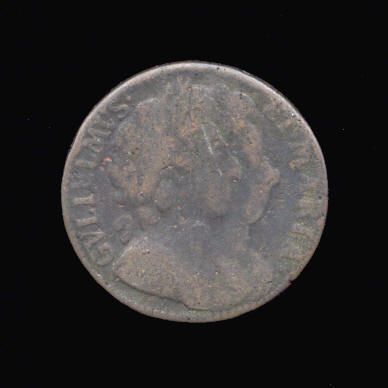

PATTERNS
There are several copper patterns of the halfpenny known, which I will now describe. The first four of these
may possibly be medalets or jettons.
2. O. GVLIELM-VS. REX. Large bust of the king of bold and coarse work.
R. MARIA. REGINA. Large bust of the queen of similar work. (Med. Ill. vol. i., p. 691,
No. 83.) R. 5.
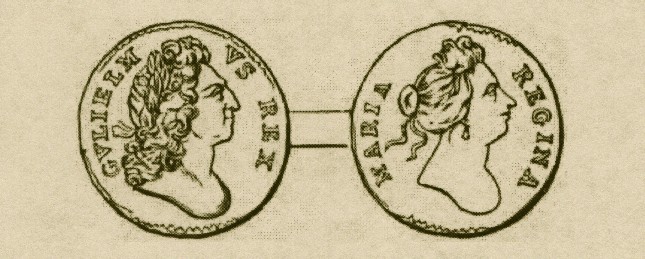
3. O. GVLIELMVS: III: DEI: GRATIA. Head of the king, laureate, with flowing hair and bare neck. Five
pellets under the bust.
R. MARIA: II: DEI: GRATIA. Bust of the queen with one lock of hair flowing down in
front. Four pellets under the bust, R. 5. The heads on this pattern (Snelling, Copp. Coins. Pl. 8, No. 1)
are small in proportion to the size of the flan, and are in fact the same as those on the pattern farthings or
medalets afterwards mentioned. (Med. Ill., Vol. I., p. 690, No. 80.)
4. O. GVLIELM-VS. REX. Bust of the king, no armour, hair short.
R. MARIA. REGINA. Bust of the queen with hair flaming and peculiarly dressed--a
long ringlet falling over the left shoulder. An open quatrefoil before the legend. R. 8.
5. O. GVLIELMVS. ET. MARIA. Busts as on the tin halfpenny.
R. ENGLISH. COPPER. On a shield the crosses of St. George and St. Andrew combined,
surmounted by a small ornament resembling an escallop shell. R. 6.
7. O. GVLIELMVS. ET. MARIA. Busts as usual, but of rather inferior work, on a larger flan than usual,
with a broad beaded circle on obverse and reverse. The king's armour is more ornamented than on the current halfpenny.
R. BRITANNIA. 1694. Figure as usual, with globe beneath, but the
head of Britannia is much smaller than usual, and the figure generally has a less matronly appearance.
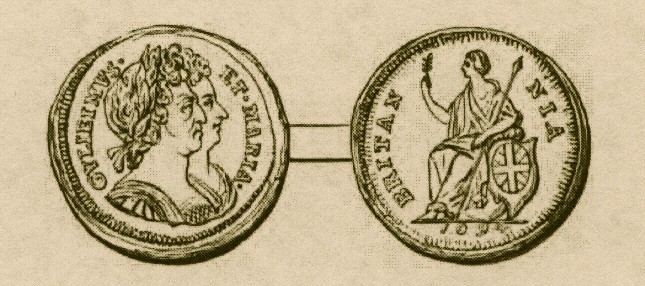
8. O. GVLIELMVS. ET. MARIA. Busts of the king and queen, of very bold but inferior work, in very high relief.
R. BRITANNIA. The figure of the same bold work in high relief; hair dressed
differently from that on the ordinary type, and the globe beneath is wanting. R. 7.
11. O. GVLIELMVS. ET. MARIA. D. G. The heads of the king and queen in mantles, without armour.
R. HISCE. SVFFVLTA. The crown supported by three pillars bearing respectively the words
RELIGIO-LEX. ET-LIBERTAS.
12. O. As No. 11.
R. IGNIBVS. IMPAR. A ship on fire; at the stern a flag flying bearing the
three fleur de lys of France.
13. O. As No. 11.
R. IVNGIT. AMOR. PATRIAEQ. SALVS. Two arms issuing from clouds on the right and
left sides of the piece, grasping together a sceptre which passes through a crown.
14. O. As the reverse of No. 11.
R. As the reverse of No. 13. var. (b.)
15. O. GVLIELMVS III. DEI. GRA. The king's bust laureate with long flowing hair and bare neck.
R. MARIA II. DEI. GRA. The queen's bust with the hair gathered up at the
back in a knot; one lock flowing down in front.
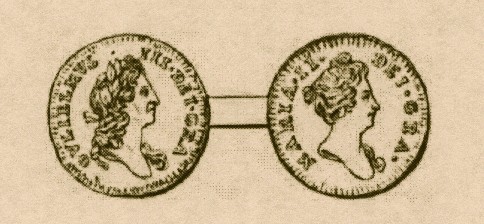
16. O. As No. 15, but with DEI. GRATIA.
R. As No. 15, but with DEI. GRATIA. In copper.
17. O. GVLIELMVS. TERTIVS. D. G. Bust as on No. 15.
R. As No. 15. In copper.
18. O. As reverse of No. 15.
R. EX. CANDORE. DECVS. A rose tree with a rose in full bloom.
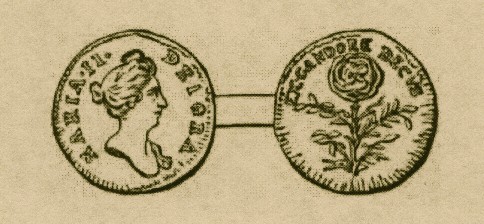
19. O. As reverse of No. 15.
R. EX. NOCTE. DIEM. The full moon shining from among clouds on a landscape.
20. O. As reverse of No. 18.
R. As reverse of No. 19.
21. O. As No. 15.
R. As No. 12.
22. O. As No. 15.
R. NON. DEVIO. The sun shining.
23. O. An elephant to the left. No legend.
R. LONDON: GOD: PRESERVE. The arms of the city; a star below the shield. R. 3.
24. O. As the last.
R. LON | DON. The arms of the city; a star above and below the shield. R. 6.
25. O. GVLIELMVS III. DEI. GRA. Large bust of the king, penetrating the inscription above and below.
R. MAG. BR. FRA. ET. HIB. REX. 1691. The arms cruciform and with the Dutch lion
on a shield of pretence in the centre, as on the silver coins.